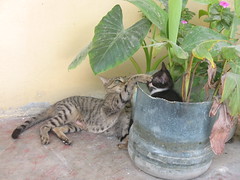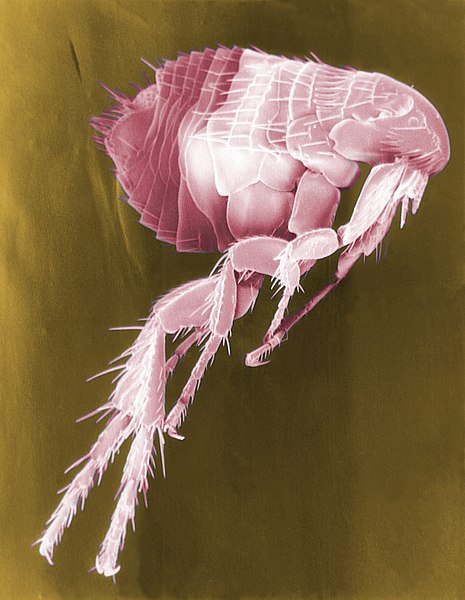 Allergies. The very word causes many people to shudder. The itchy eyes, stuffy and runny nose aren’t fun to deal with, but a lot of us suffer from allergies; about 1 in every 4 Americans has an allergy of some sort. Some of the more common allergies are seasonal allergies (outdoor allergies) and pet allergies (indoor allergies). So, what are you supposed to do if you want a dog or a cat, but you are allergic to their dander? Depending on the severity of your symptoms there may be a way to reduce your symptoms if you decide to adopt a pet.
Allergies. The very word causes many people to shudder. The itchy eyes, stuffy and runny nose aren’t fun to deal with, but a lot of us suffer from allergies; about 1 in every 4 Americans has an allergy of some sort. Some of the more common allergies are seasonal allergies (outdoor allergies) and pet allergies (indoor allergies). So, what are you supposed to do if you want a dog or a cat, but you are allergic to their dander? Depending on the severity of your symptoms there may be a way to reduce your symptoms if you decide to adopt a pet.
 There are many dogs and a few cats available today that are advertised as ‘hypoallergenic breeds’. They are usually smaller companion dogs, such as Yorkies, Bichon Frises, and Maltese, or hairless breeds of cats and dogs. The truth is there is not a single breed that is hypoallergenic. All dogs and cats produce dander, excess hair and saliva that contain the allergens that cause our allergic symptoms. These smaller dogs and hairless breeds are often presented as hypoallergenic because they simply produce fewer allergens. These breeds have a slower shedding cycle and often require frequent haircuts and grooming to keep their hair a manageable length. The size of the dog is also relevant, as a larger dog will produce more dander and excess fur! Even with these benefits it is important to note that so-called hypoallergenic breeds produce allergens, and each pet is individual and can produce more allergens than its littermate.
There are many dogs and a few cats available today that are advertised as ‘hypoallergenic breeds’. They are usually smaller companion dogs, such as Yorkies, Bichon Frises, and Maltese, or hairless breeds of cats and dogs. The truth is there is not a single breed that is hypoallergenic. All dogs and cats produce dander, excess hair and saliva that contain the allergens that cause our allergic symptoms. These smaller dogs and hairless breeds are often presented as hypoallergenic because they simply produce fewer allergens. These breeds have a slower shedding cycle and often require frequent haircuts and grooming to keep their hair a manageable length. The size of the dog is also relevant, as a larger dog will produce more dander and excess fur! Even with these benefits it is important to note that so-called hypoallergenic breeds produce allergens, and each pet is individual and can produce more allergens than its littermate.
What is a pet lover to do if a family member (or yourself) has an allergy? There are some options, though admittedly they are limited. If you are willing, there are many pharmaceuticals available both with a prescription and without to alleviate your allergy symptoms. Schedule a visit with your doctor to discuss your personal options, and any risks associated with medication.
You may also want to consider the size and coat-type of your pet. Choose a smaller pet (who produces fewer allergens) and one that doesn’t shed excessively. A German Shepherd or a Siberian Husky might not be best option for a household with allergies. No matter what breed you adopt you will want to adjust your cleaning regime.
 Reducing allergens in your home is possible, but can be costly depending on how resolute you are. Some of the more manageable changes include vacuuming flooring and furniture daily, washing rugs and throws frequently, washing pet bedding and crates weekly, washing your clothing after a single wear, and washing your curtains, blinds and linens frequently. If you are purchasing a new vacuum cleaner, look for one designed for pet hair and one that contains a HEPA filter, which you should change every month or two.
Reducing allergens in your home is possible, but can be costly depending on how resolute you are. Some of the more manageable changes include vacuuming flooring and furniture daily, washing rugs and throws frequently, washing pet bedding and crates weekly, washing your clothing after a single wear, and washing your curtains, blinds and linens frequently. If you are purchasing a new vacuum cleaner, look for one designed for pet hair and one that contains a HEPA filter, which you should change every month or two.
If you have central air or forced heat in your home the ventilation system is spreading allergens throughout your home. Consider fitting your unit with a HEPA filter, or investing in a central air purifier which, when used at least 4 hours a day, can significantly reduce allergens in your home. If you plan to make major renovations to your home, consider opting for hard wood or linoleum flooring instead of carpeting, and limit your use of area rugs and throws.
 A lot of dog lovers, including myself, love to share the bed with pets. If you have allergies, you might want to think twice about snuggling up with Fido for 8 hours each night. You might sleep more peacefully, and feel better in the morning, if your bedroom is strictly pet-free. Set up your pets a warm, comfy bed in another room, or consider crate-training your pet at night and when you are away from the house. Most pets can be conditioned to enjoy time in their crate if you take the time to train them properly. You should also invest in dust covers for your mattresses and pillows to keep any residual pet allergens at bay.
A lot of dog lovers, including myself, love to share the bed with pets. If you have allergies, you might want to think twice about snuggling up with Fido for 8 hours each night. You might sleep more peacefully, and feel better in the morning, if your bedroom is strictly pet-free. Set up your pets a warm, comfy bed in another room, or consider crate-training your pet at night and when you are away from the house. Most pets can be conditioned to enjoy time in their crate if you take the time to train them properly. You should also invest in dust covers for your mattresses and pillows to keep any residual pet allergens at bay.
There are also some grooming habits that can reduce the number of allergens your pet spreads in your home. Consider bathing your pet or having them groomed once over week or two, as long as their skin doesn’t dry out or become itchy. In between baths, have a non-allergic member of your family wipe your pet’s fur with a bath wipe or baby wipe every day or two. To reduce even more allergies, have them do this outside of the home and immediately dispose of the wipes in the garbage.
Make it a habit to wash your hands after interacting or petting your animal, and don’t touch your eyes or face immediately after touching them. If you can’t find a non-allergic family member to do the cleaning or grooming while you are out of the house, arm yourself with a dust mask to reduce the number of allergens you are exposed to during these sometimes unpleasant, but necessary tasks. Always have an antihistamine on hand (such as Benadryl) in case of a sudden allergy attack.
 If you are or a family member is allergic to dogs, and you choose to try to manage that allergy and adopt a dog, be sure to have a solid back-up plan in case the allergies become unbearable. Allergies can build and develop over time, so after a few months living with your new pet, allergies might become more severe. Before bringing your pet home, develop a back-up plan to either co-exist with your pet and your allergies, and have an alternative home set up ahead of time with a reliable friend or family member who will care for the pet if you are unable to. After you adopt a pet, they become your responsibility to care for. It isn’t fair to your new pet to be put back into a shelter for something that they cannot control. We’re all pet lovers and advocates here, so I don’t think that won’t be a problem among our readers.
If you are or a family member is allergic to dogs, and you choose to try to manage that allergy and adopt a dog, be sure to have a solid back-up plan in case the allergies become unbearable. Allergies can build and develop over time, so after a few months living with your new pet, allergies might become more severe. Before bringing your pet home, develop a back-up plan to either co-exist with your pet and your allergies, and have an alternative home set up ahead of time with a reliable friend or family member who will care for the pet if you are unable to. After you adopt a pet, they become your responsibility to care for. It isn’t fair to your new pet to be put back into a shelter for something that they cannot control. We’re all pet lovers and advocates here, so I don’t think that won’t be a problem among our readers.
Owning a pet can be a rewarding experience that is second to none. Often the companionship and friendship that your furry friend will give you outweigh the hassle of allergy shots, excessive cleanliness, and expense that comes with managing allergies. Each person, pet, and their allergies/allergens are unique. Do plenty of research and prepare yourself well in advance of choosing a pet and you will be rewarded tenfold.
Thanks,
Heather
 No one wants to lose a pet, but sometimes in the hustle and bustle of daily life, a dog or cat can slip through the front door and vanish in seconds. It is a heart-wrenching situation, but there are some steps you can take to help your pet return home quickly and safely. I’ve only lost a pet once, my cat Bella many years ago, but I learned a lot from the situation.
No one wants to lose a pet, but sometimes in the hustle and bustle of daily life, a dog or cat can slip through the front door and vanish in seconds. It is a heart-wrenching situation, but there are some steps you can take to help your pet return home quickly and safely. I’ve only lost a pet once, my cat Bella many years ago, but I learned a lot from the situation. That Pet Blog That Pet Place Pet Blog
That Pet Blog That Pet Place Pet Blog










 If you are or a family member is allergic to dogs, and you choose to try to manage that allergy and adopt a dog, be sure to have a solid back-up plan in case the allergies become unbearable. Allergies can build and develop over time, so after a few months living with your new pet, allergies might become more severe. Before bringing your pet home, develop a back-up plan to either co-exist with your pet and your allergies, and have an alternative home set up ahead of time with a reliable friend or family member who will care for the pet if you are unable to. After you adopt a pet, they become your responsibility to care for. It isn’t fair to your new pet to be put back into a shelter for something that they cannot control. We’re all pet lovers and advocates here, so I don’t think that won’t be a problem among our readers.
If you are or a family member is allergic to dogs, and you choose to try to manage that allergy and adopt a dog, be sure to have a solid back-up plan in case the allergies become unbearable. Allergies can build and develop over time, so after a few months living with your new pet, allergies might become more severe. Before bringing your pet home, develop a back-up plan to either co-exist with your pet and your allergies, and have an alternative home set up ahead of time with a reliable friend or family member who will care for the pet if you are unable to. After you adopt a pet, they become your responsibility to care for. It isn’t fair to your new pet to be put back into a shelter for something that they cannot control. We’re all pet lovers and advocates here, so I don’t think that won’t be a problem among our readers.


